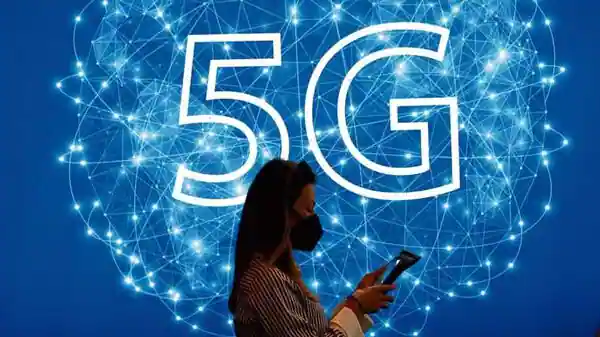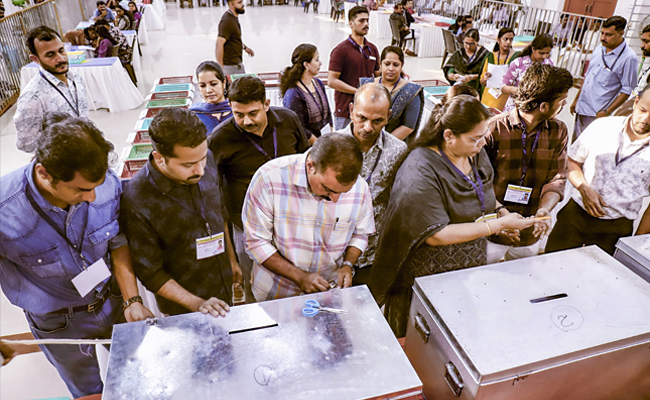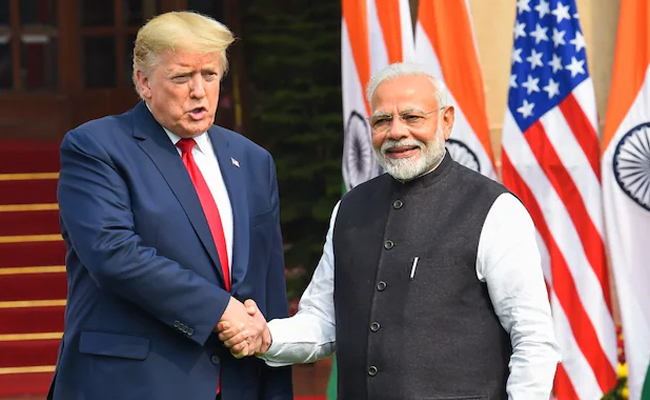New Delhi, Jul 26: Firms run by tycoons Mukesh Ambani, Sunil Bharti Mittal and Gautam Adani bid about Rs 1.45 lakh crore to buy fifth-generation (5G) airwaves on the opening day of India's largest-ever spectrum auction on Tuesday.
Telecom Minister Ashwini Vaishnaw said the response on the first day of the auction exceeded all expectations and will surpass the records of 2015, when revenue collection from auction stood at Rs 1.09 lakh crore.
Even the 700 MHz band, which had not seen any takers in the 2016 and 2021 auctions, received bids this time. As per information put out by the telecom department, in the coveted 700 MHz band, provisional bids worth Rs 39,270 crore were received on day-one of auction, industry watchers said.
All four applicants -- Ambani's Reliance Jio, Mittal's Bharti Airtel, Vodafone Idea and an Adani group firm "actively" participated in the auction of the 5G spectrum, which offers ultra-high speeds (about 10 times faster than 4G), lag-free connectivity, and can enable billions of connected devices to share data in real-time.
As per the process, it will not be known until the close which company got how much of airwaves. All the radiowaves sold on day one were at the reserve price.
Describing the participation by four bidders as 'strong', the minister said bids worth Rs 1.45 lakh crore came in on day one. The auction saw healthy participation, he said, adding the response shows that the industry has turned from its difficult time caused by litigation.
"Now industry is getting converted to sunrise industry...Bids of about Rs 1,45,000 crore show that the industry is moving towards positive territory, now new investments will come, service quality will improve, and new technology will be introduced," the minister said.
The bidding and demand seen on the first day is over 80 per cent more than government's internal estimates of Rs 80,000 crore. The minister acknowledged that response had gone "far beyond our expectations". He added that going by the current participation levels, auctions would surpass the budgeted provisions.
The government, he said, will allocate the spectrum in record time and 5G services are expected to start rolling out by September-October timeframe. The target is to allocate the spectrum by August 14-15, he said.
Four rounds of bidding were held on the opening day, with mid and high-end bands seeing keen interest. Bids were received for 7 out of 9 bands with more than half of the total bids (in value terms) coming in from 3,300 megahertz band - which is for 5G communications. As much as Rs 78,550 crore worth of bids were made for spectrum in the 3,300 MHz band, market experts analysing DoT data said.
The 700 MHz band, which is being widely used by the telcos in the West for a cost-efficient deployment, received Rs 39,270 crore worth of provisional bids while millimetre wave band 26 GHz, which allows for ultra-high-speed mobile broadband services, was the third most sought after band with bids worth Rs 14,632.50 crore.
No bids were received for 800 MHz and 2,300 MHz bands.
In addition to powering ultra-low latency connections, which allow downloading full-length high-quality video or movie to a mobile device in a matter of seconds (even in crowded areas), fifth generation or 5G would enable solutions such as e-health, connected vehicles, more immersive augmented reality and metaverse experiences, life-saving use cases, and advanced mobile cloud gaming, among others.
In all the auction is being held for spectrum in various low (600 MHz, 700 MHz, 800 MHz, 900 MHz, 1,800 MHz, 2,100 MHz, 2,300 MHz), mid (3,300 MHz) and high (26 GHz) frequency bands.
A total of 72 GHz (gigahertz) of radiowaves worth at least Rs 4.3 lakh crore is up for bidding.
The auction will continue on Wednesday, and is likely to conclude tomorrow itself.
Asked how much will the bids go beyond Rs 1.45 lakh crore levels seen on day one, the minister said, "It looks like it will be at that level, but nothing can be said till the auction is ongoing".
The minister assured that consumers will be able to experience 5G services in many cities by 2022-end.
"Spectrum is basic raw material for telecom. Good spectrum can improve telecom services. In coming months and years, quality of service will improve significantly," Vaishnaw said, adding India's indigenous 5G stack too will be ready in a few months.
Prashant Singhal, EY Global TMT Emerging Markets Leader, said the first day of spectrum auction was in line with the expectations, particularly when it came to 3,300 MHz and 26 GHz bands.
"It clearly highlights that coveted 5G spectrum is much in demand. Bidding in the 700 MHz band was surprising considering the spectrum price. However, it is reflective of the need to provide pan-India coverage for 5G, especially in the rural areas," Singhal said.
There is no excess demand in any of the bands, Singhal said, adding if the trend continued, the bidding is expected to be over as soon as 100 per cent activity is reached.
"The auction is likely to witness higher than market estimates," he added.
In the auction conducted in 2021 - that had lasted two days - Reliance Jio had picked up spectrum worth Rs 57,122.65 crore, Bharti Airtel bid about Rs 18,699 crore, and Vodafone Idea bought spectrum worth Rs 1,993.40 crore.
Let the Truth be known. If you read VB and like VB, please be a VB Supporter and Help us deliver the Truth to one and all.
Thiruvananthapuram (PTI): Buoyed by the strong performance of the Congress-led UDF in the local body polls, KPCC president Sunny Joseph said on Saturday that the front's results indicated the people had rejected the LDF government.
According to early trends, the UDF was leading in more grama panchayats, block panchayats, municipalities and corporations than the LDF.
The local body polls were held in two phases in the state earlier this week.
ALSO READ: Cong candidate who moved Kerala HC for name reinstatement in voter list, wins
Speaking to reporters here, Joseph said the people of Kerala had extended their support to the UDF.
"We could expose the LDF government’s anti-people stance and the people understood it. The LDF’s fake propaganda was rejected by the people. The UDF is moving towards a historic victory," he said.
He said a united effort, proper preparations, good candidate selection and hard work had resulted in the Congress and the UDF’s victory in the elections.
Asked about the prospects in the Thiruvananthapuram Corporation, Joseph said the party was studying the matter and would comment later.
LDF convenor T P Ramakrishnan said the results would be closely examined.
According to him, the government had done everything possible for the people.
"Why such a verdict happened will be examined at the micro level. People’s opinion will be considered and further steps will be taken," he said.
He added that decisions would be taken after analysing the results. "If any corrective measures are required, we will initiate them and move forward," he said.
AICC leader K C Venugopal said the results showed that people had begun ousting those who, he alleged, were responsible for the loss of gold at Lord Ayyappa’s temple.
"This trend will continue in the Assembly elections as well. It is an indication that the people are ready to bring down the LDF government," he said.
Venugopal said the UDF had registered victories even in CPI(M) and LDF strongholds.
"I congratulate all UDF workers for their hard work. Congress workers and leaders worked unitedly," he said.
Referring to remarks made by Chief Minister Pinarayi Vijayan against the Congress on polling day, Venugopal said the voters had responded through the verdict.
"I do not know whether the chief minister understands that the people are against him. Otherwise, he does not know the sentiment of the people. The state government cannot move an inch further," he said.
He said the results indicated a strong comeback for the UDF in Kerala.
Asked whether the Sabarimala gold loss issue had affected the LDF in the local polls, Venugopal said the CM and the CPI(M) state secretary did not take the issue seriously.
"We took a strong stand on the matter. The BJP played a foul game in it," he alleged.
On the BJP's role in the local body elections, Venugopal alleged that the party operated with the CPI(M) 's tacit support.
"The CPI(M) supported the central government on issues such as PM-SHRI, labour codes and corruption in national highway construction. The CPI(M) is facing ideological decline, and the state government’s policies are against the party’s own decisions," he said.
Meanwhile, LDF ally Kerala Congress (M) leader Jose K Mani said the party could not win all the wards it had expected in the elections.
He congratulated winners from all parties and said the party would closely examine the losses and identify shortcomings. "Later, we will take corrective measures," he added.
Senior Congress leader and MP Rajmohan Unnithan said the trends in the local body elections indicated that the UDF would return to power in the 2026 Assembly elections.
"We will win 111 seats as in 1977 and return to power in 2026. The anti-government sentiment of the people is reflected in the elections," he said.
Unnithan said the people were disturbed and unhappy with the present government.
"The trend indicates the end of the LDF government," he added.
CPI(M) MLA M M Mani said the people had shown ingratitude towards the LDF despite benefiting from welfare schemes.
"After receiving all welfare schemes and living comfortably, people voted against us due to some temporary sentiments. Is that not ingratitude," he asked.
Mani said no such welfare initiatives had taken place in Kerala earlier.
"People are receiving pensions and have enough to eat. Even after getting all this, they voted against us. This is what can be called ingratitude," he said.
Muslim League state president Panakkad Sayyid Sadiq Ali Shihab Thangal said the results were beyond expectations.
"The outcome points towards the Secretariat in Thiruvananthapuram, indicating that a change of government is imminent. We are going to win the Assembly election," he said.





